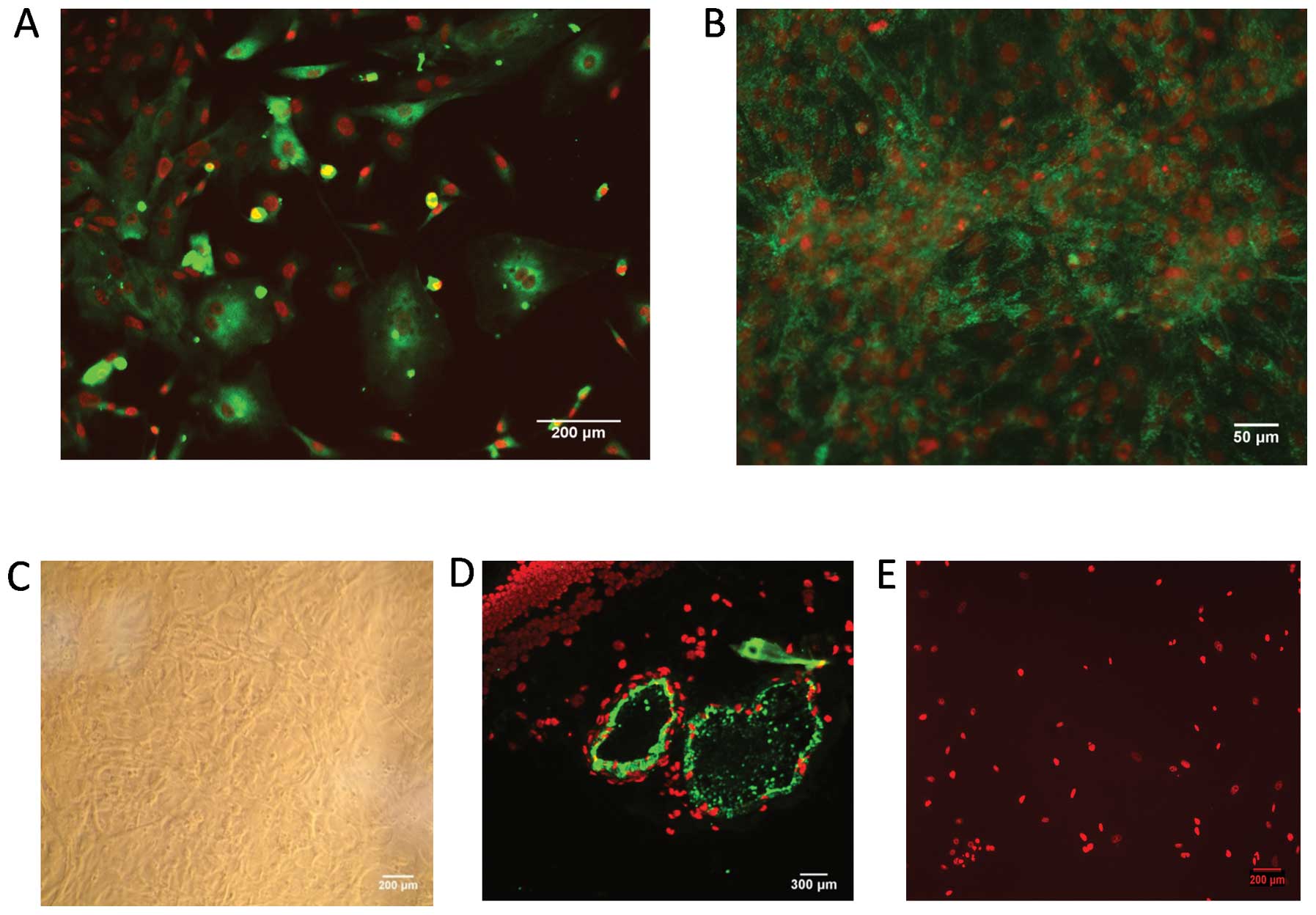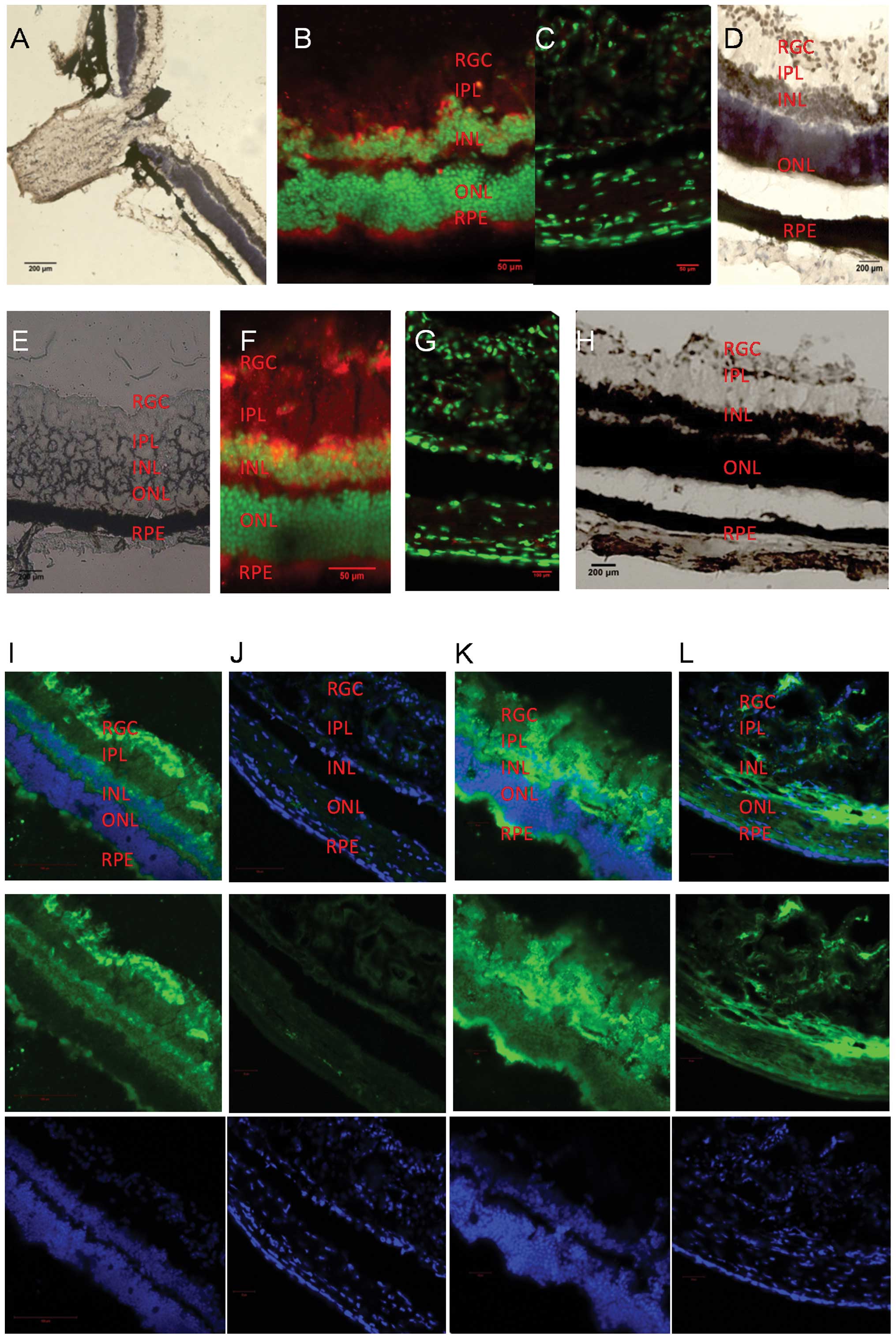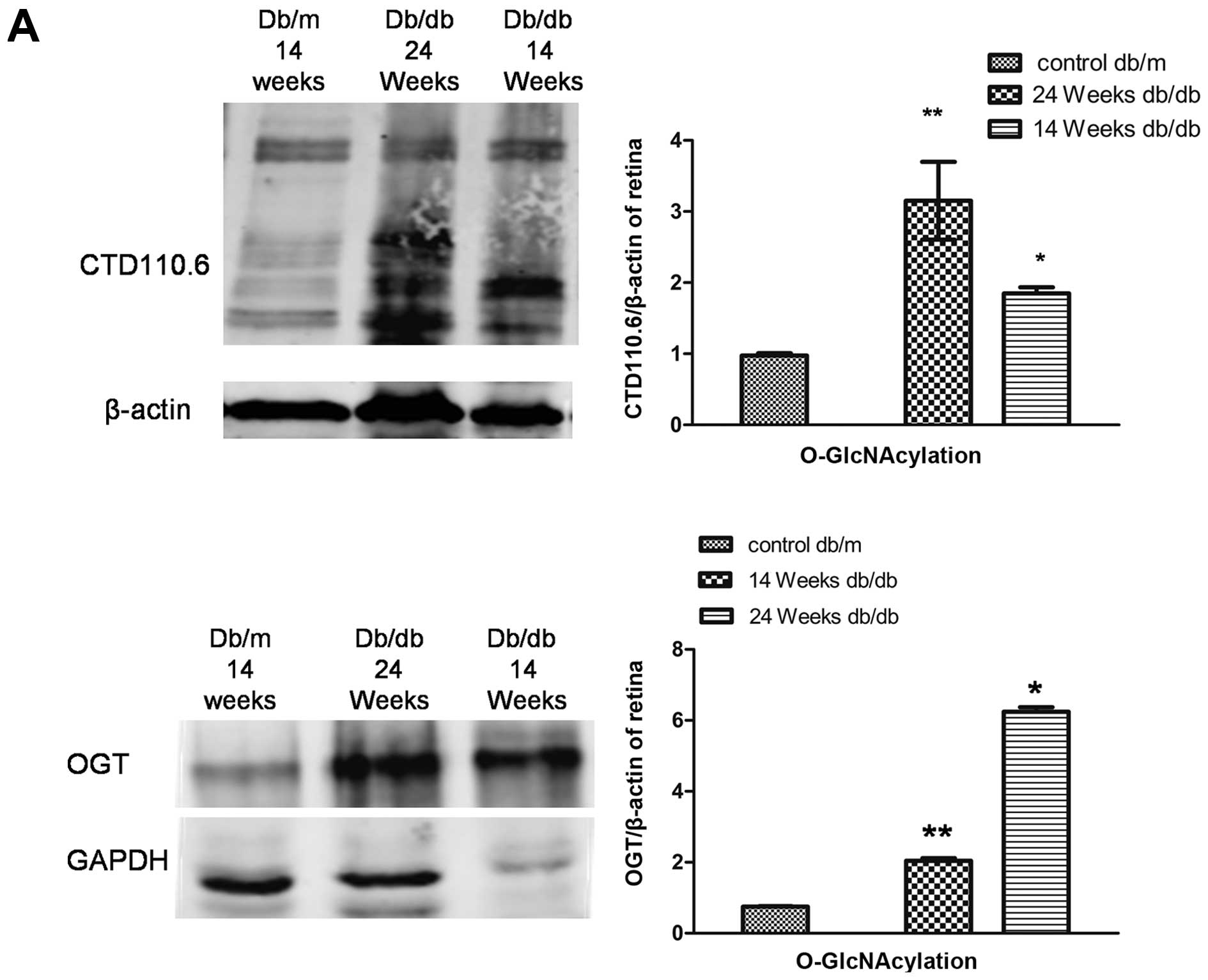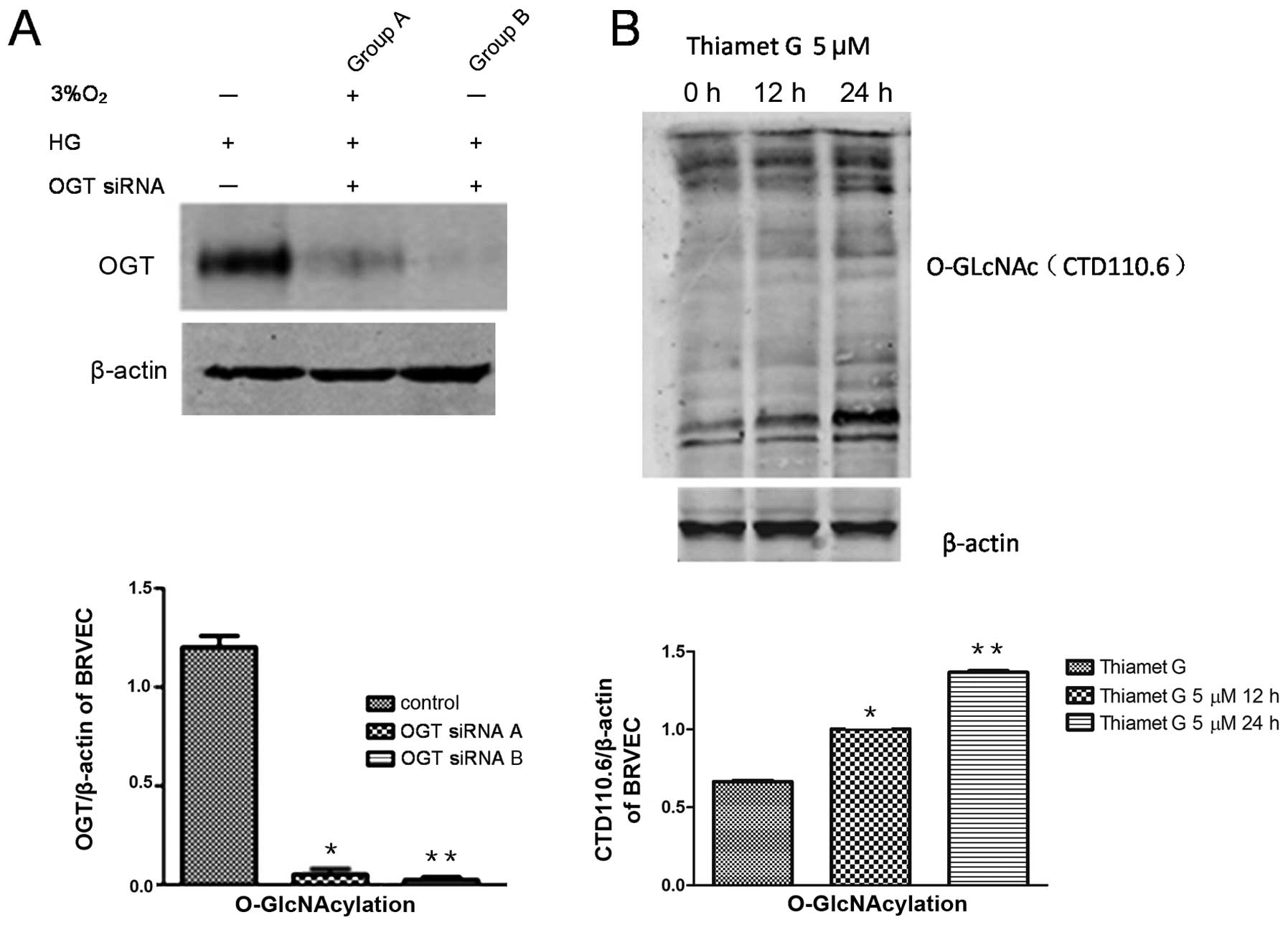|
1
|
Torres CR and Hart GW: Topography and
polypeptide distribution of terminal N-acetylglucosamine residues
on the surfaces of intact lymphocytes. Evidence for O-linked
GlcNAc. J Biol Chem. 259:3308–3317. 1984.
|
|
2
|
Hart GW, Housley MP and Slawson C: Cycling
of O-linked beta-N-acetylglucosamine on nucleocytoplasmic proteins.
Nature. 446:1017–1022. 2007. View Article : Google Scholar : PubMed/NCBI
|
|
3
|
Lima VV, Rigsby CS, Hardy DM, Webb RC and
Tostes RC: O-GlcNAcylation: a novel post-translational mechanism to
alter vascular cellular signaling in health and disease: focus on
hypertension. J Am Soc Hypertens. 3:374–387. 2009. View Article : Google Scholar : PubMed/NCBI
|
|
4
|
Lima VV, Spitler K, Choi H, Webb RC and
Tostes RC: O-GlcNAcylation and oxidation of proteins: is signalling
in the cardiovascular system becoming sweeter? Clin Sci (Lond).
123:473–486. 2012. View Article : Google Scholar : PubMed/NCBI
|
|
5
|
Lima VV, Giachini FR, Carneiro FS, et al:
Increased vascular O-GlcNAcylation augments reactivity to
constrictor stimuli - VASOACTIVE PEPTIDE SYMPOSIUM. J Am Soc
Hypertens. 2:410–417. 2008. View Article : Google Scholar : PubMed/NCBI
|
|
6
|
Kim do H, Seok YM, Kim IK, Lee IK, Jeong
SY and Jeoung NH: Glucosamine increases vascular contraction
through activation of RhoA/Rho kinase pathway in isolated rat
aorta. BMB Rep. 44:415–420. 2011.
|
|
7
|
Grimm C and Willmann G: Hypoxia in the
eye: a two-sided coin. High Alt Med Biol. 13:169–175. 2012.
View Article : Google Scholar : PubMed/NCBI
|
|
8
|
Banumathi E, Haribalaganesh R, Babu SS,
Kumar NS and Sangiliyandi G: High-yielding enzymatic method for
isolation and culture of microvascular endothelial cells from
bovine retinal blood vessels. Microvasc Res. 77:377–381. 2009.
View Article : Google Scholar : PubMed/NCBI
|
|
9
|
Ali TK and El-Remessy AB: Diabetic
retinopathy: current management and experimental therapeutic
targets. Pharmacotherapy. 29:182–192. 2009. View Article : Google Scholar : PubMed/NCBI
|
|
10
|
Ruan HB, Singh JP, Li MD, Wu J and Yang X:
Cracking the O-GlcNAc code in metabolism. Trends Endocrinol Metab.
24:301–309. 2013. View Article : Google Scholar : PubMed/NCBI
|
|
11
|
Jensen RV, Zachara NE, Nielsen PH, Kimose
HH, Kristiansen SB and Botker HE: Impact of O-GlcNAc on
cardioprotection by remote ischaemic preconditioning in
non-diabetic and diabetic patients. Cardiovasc Res. 97:369–378.
2013. View Article : Google Scholar : PubMed/NCBI
|
|
12
|
Bennett CE, Johnsen VL, Shearer J and
Belke DD: Exercise training mitigates aberrant cardiac protein
O-GlcNAcylation in streptozotocin-induced diabetic mice. Life Sci.
92:657–663. 2013. View Article : Google Scholar : PubMed/NCBI
|
|
13
|
McLarty JL, Marsh SA and Chatham JC:
Post-translational protein modification by O-linked
N-acetyl-glucosamine: its role in mediating the adverse effects of
diabetes on the heart. Life Sci. 92:621–627. 2013. View Article : Google Scholar : PubMed/NCBI
|
|
14
|
Gurel Z, Sieg KM, Shallow KD, Sorenson CM
and Sheibani N: Retinal O-linked N-acetylglucosamine protein
modifications: implications for postnatal retinal vascularization
and the pathogenesis of diabetic retinopathy. Mol Vis.
19:1047–1059. 2013.
|
|
15
|
Zachara NE, Molina H, Wong KY, Pandey A
and Hart GW: The dynamic stress-induced ‘O-GlcNAc-ome’ highlights
functions for O-GlcNAc in regulating DNA damage/repair and other
cellular pathways. Amino Acids. 40:793–808. 2011.
|
|
16
|
Tai TC, Wong-Faull DC, Claycomb R and Wong
DL: Hypoxic stress-induced changes in adrenergic function: role of
HIF1 alpha. J Neurochem. 109:513–524. 2009. View Article : Google Scholar : PubMed/NCBI
|
|
17
|
Witt KA, Mark KS, Huber J and Davis TP:
Hypoxia-inducible factor and nuclear factor kappa-B activation in
blood-brain barrier endothelium under hypoxic/reoxygenation stress.
J Neurochem. 92:203–214. 2005. View Article : Google Scholar
|
|
18
|
Arden GB and Sivaprasad S: Hypoxia and
oxidative stress in the causation of diabetic retinopathy. Curr
Diabetes Rev. 7:291–304. 2011. View Article : Google Scholar : PubMed/NCBI
|
|
19
|
Li C, Chen P, Zhang J, et al:
Enzyme-induced vitreolysis can alleviate the progression of
diabetic retinopathy through the HIF-1alpha pathway. Invest
Ophthalmol Vis Sci. 54:4964–4970. 2013. View Article : Google Scholar : PubMed/NCBI
|
|
20
|
Zachara NE, O’Donnell N, Cheung WD, Mercer
JJ, Marth JD and Hart GW: Dynamic O-GlcNAc modification of
nucleocytoplasmic proteins in response to stress. A survival
response of mammalian cells. J Biol Chem. 279:30133–30142. 2004.
View Article : Google Scholar : PubMed/NCBI
|
|
21
|
Arvanitis LD, Vassiou K, Kotrotsios A and
Sgantzos MN: Hypoxia upregulates the expression of the O-linked
N-acetylglucosamine containing epitope H in human ependymal cells.
Pathol Res Pract. 207:91–96. 2011. View Article : Google Scholar : PubMed/NCBI
|
|
22
|
Ngoh GA, Watson LJ, Facundo HT, Dillmann W
and Jones SP: Non-canonical glycosyltransferase modulates
post-hypoxic cardiac myocyte death and mitochondrial permeability
transition. J Mol Cell Cardiol. 45:313–325. 2008. View Article : Google Scholar : PubMed/NCBI
|
|
23
|
Ngoh GA, Facundo HT, Zafir A and Jones SP:
O-GlcNAc signaling in the cardiovascular system. Circ Res.
107:171–185. 2010. View Article : Google Scholar : PubMed/NCBI
|
|
24
|
Araki E, Oyadomari S and Mori M:
Endoplasmic reticulum stress and diabetes mellitus. Intern Med.
42:7–14. 2003. View Article : Google Scholar
|
|
25
|
Harding HP, Zeng H, Zhang Y, et al:
Diabetes mellitus and exocrine pancreatic dysfunction in
perk−/− mice reveals a role for translational control in
secretory cell survival. Mol Cell. 7:1153–1163. 2001. View Article : Google Scholar : PubMed/NCBI
|
|
26
|
Ozcan U, Cao Q, Yilmaz E, et al:
Endoplasmic reticulum stress links obesity, insulin action, and
type 2 diabetes. Science. 306:457–461. 2004. View Article : Google Scholar : PubMed/NCBI
|
|
27
|
Jones SP, Zachara NE, Ngoh GA, et al:
Cardioprotection by N-acetylglucosamine linkage to cellular
proteins. Circulation. 117:1172–1182. 2008. View Article : Google Scholar : PubMed/NCBI
|
|
28
|
Liu J, Marchase RB and Chatham JC:
Increased O-GlcNAc levels during reperfusion lead to improved
functional recovery and reduced calpain proteolysis. Am J Physiol
Heart Circ Physiol. 293:H1391–H1399. 2007. View Article : Google Scholar : PubMed/NCBI
|
|
29
|
Ngoh GA, Facundo HT, Hamid T, Dillmann W,
Zachara NE and Jones SP: Unique hexosaminidase reduces metabolic
survival signal and sensitizes cardiac myocytes to
hypoxia/reoxygenation injury. Circ Res. 104:41–49. 2009. View Article : Google Scholar : PubMed/NCBI
|
|
30
|
Champattanachai V, Marchase RB and Chatham
JC: Glucosamine protects neonatal cardiomyocytes from
ischemia-reperfusion injury via increased protein O-GlcNAc and
increased mitochondrial Bcl-2. Am J Physiol Cell Physiol.
294:C1509–C1520. 2008. View Article : Google Scholar : PubMed/NCBI
|
|
31
|
Ngoh GA, Hamid T, Prabhu SD and Jones SP:
O-GlcNAc signaling attenuates ER stress-induced cardiomyocyte
death. Am J Physiol Heart Circ Physiol. 297:H1711–H1719. 2009.
View Article : Google Scholar : PubMed/NCBI
|
|
32
|
Hanover JA, Krause MW and Love DC: The
hexosamine signaling pathway: O-GlcNAc cycling in feast or famine.
Biochim Biophys Acta. 1800:80–95. 2010. View Article : Google Scholar : PubMed/NCBI
|
|
33
|
Guinez C, Mir AM, Leroy Y, Cacan R,
Michalski JC and Lefebvre T: Hsp70-GlcNAc-binding activity is
released by stress, proteasome inhibition, and protein misfolding.
Biochem Biophys Res Commun. 361:414–420. 2007. View Article : Google Scholar : PubMed/NCBI
|
|
34
|
Kennedy A and Frank RN: The influence of
glucose concentration and hypoxia on VEGF secretion by cultured
retinal cells. Curr Eye Res. 36:168–177. 2011. View Article : Google Scholar : PubMed/NCBI
|
|
35
|
Loukovaara S, Koivunen P, Ingles M,
Escobar J, Vento M and Andersson S: Elevated protein carbonyl and
HIF-1alpha levels in eyes with proliferative diabetic retinopathy.
Acta Ophthalmol. May 29–2013.(Epub ahead of print).
|
|
36
|
Yu DY and Cringle SJ: Oxygen distribution
and consumption within the retina in vascularised and avascular
retinas and in animal models of retinal disease. Prog Retin Eye
Res. 20:175–208. 2001. View Article : Google Scholar : PubMed/NCBI
|
|
37
|
Yu DY, Cringle SJ, Yu PK and Su EN:
Intraretinal oxygen distribution and consumption during retinal
artery occlusion and graded hyperoxic ventilation in the rat.
Invest Ophthalmol Vis Sci. 48:2290–2296. 2007. View Article : Google Scholar : PubMed/NCBI
|
|
38
|
Cringle SJ and Yu DY: A multi-layer model
of retinal oxygen supply and consumption helps explain the muted
rise in inner retinal PO(2) during systemic hyperoxia. Comp Biochem
Physiol A Mol Integr Physiol. 132:61–66. 2002. View Article : Google Scholar
|
|
39
|
Yu DY, Cringle SJ and Su EN: Intraretinal
oxygen distribution in the monkey retina and the response to
systemic hyperoxia. Invest Ophthalmol Vis Sci. 46:4728–4733. 2005.
View Article : Google Scholar : PubMed/NCBI
|
|
40
|
Sandercoe TM, Geller SF, Hendrickson AE,
Stone J and Provis JM: VEGF expression by ganglion cells in central
retina before formation of the foveal depression in monkey retina:
evidence of developmental hypoxia. J Comp Neurol. 462:42–54. 2003.
View Article : Google Scholar : PubMed/NCBI
|
|
41
|
Semenza GL: Hydroxylation of HIF-1: oxygen
sensing at the molecular level. Physiology (Bethesda). 19:176–182.
2004. View Article : Google Scholar : PubMed/NCBI
|
|
42
|
Bensellam M, Duvillie B, Rybachuk G, et
al: Glucose-induced O(2) consumption activates hypoxia inducible
factors 1 and 2 in rat insulin-secreting pancreatic beta-cells.
PLoS One. 7:e298072012. View Article : Google Scholar : PubMed/NCBI
|
|
43
|
Yang L, Tan P, Zhou W, et al:
N-acetylcysteine protects against hypoxia mimetic-induced autophagy
by targeting the HIF-1 alpha pathway in retinal ganglion cells.
Cell Mol Neurobiol. 32:1275–1285. 2012. View Article : Google Scholar : PubMed/NCBI
|
|
44
|
Feldman GJ, Mullin JM and Ryan MP:
Occludin: structure, function and regulation. Adv Drug Deliv Rev.
57:883–917. 2005. View Article : Google Scholar : PubMed/NCBI
|
|
45
|
Cummins PM: Occludin: one protein, many
forms. Mol Cell Biol. 32:242–250. 2012. View Article : Google Scholar : PubMed/NCBI
|
|
46
|
Dorfel MJ and Huber O: Modulation of tight
junction structure and function by kinases and phosphatases
targeting occludin. J Biomed Biotechnol. 2012:8073562012.
View Article : Google Scholar : PubMed/NCBI
|
|
47
|
Clarke H, Soler AP and Mullin JM: Protein
kinase C activation leads to dephosphorylation of occludin and
tight junction permeability increase in LLC-PK1 epithelial cell
sheets. J Cell Sci. 113(Pt 18): 3187–3196. 2000.PubMed/NCBI
|
|
48
|
Simonovic I, Arpin M, Koutsouris A,
Falk-Krzesinski HJ and Hecht G: Enteropathogenic Escherichia
coli activates ezrin, which participates in disruption of tight
junction barrier function. Infect Immun. 69:5679–5688.
2001.PubMed/NCBI
|
|
49
|
Butt AM, Feng D, Nasrullah I, et al:
Computational identification of interplay between phosphorylation
and O-beta-glycosylation of human occludin as potential mechanism
to impair hepatitis C virus entry. Infect Genet Evol. 12:1235–1245.
2012. View Article : Google Scholar : PubMed/NCBI
|













